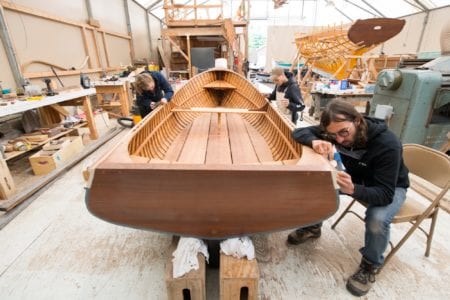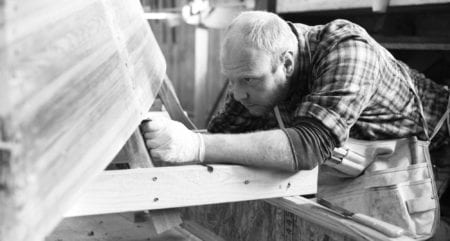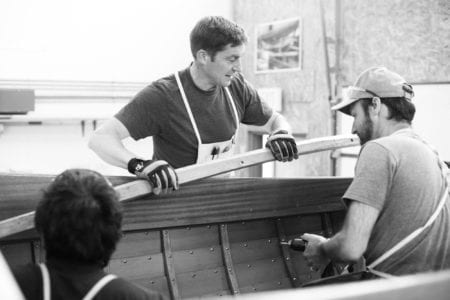At the Northwest School of Wooden Boatbuilding, students learn how to preserve century-old wooden ships. It’s a dying art, but those skills help keep modern commercial fleets working properly, too.
For Port Townsend, Wash., locals like Leland Gibson, wooden boatbuilding isn’t just a quaint hobby — it’s a craft that can provide a reliable livelihood. Working for Haven Boatworks for 10 years, Gibson plied his trade restoring antiques like the S/V Adventuress, a century-old tall ship that is now used for environmental education, repairing salmon trollers in need of patchwork before they headed up to Alaska to fish, and repairing a dozen more modern and traditional wooden vessels.
Where did Gibson acquire this rare set of skills? At the Northwest School of Wooden Boatbuilding (NWSWB), located just outside Port Townsend on the Olympic Peninsula in a town called Port Hadlock. In an age where fiberglass and epoxy have become the norm, the school is dedicated to giving its students the necessary experience to carry the wooden boat tradition forward.
Wooden Boat Basics and Beyond
Fearing that maritime traditions and wooden boatbuilding techniques were slipping away, Bob Prothero, Libby Palmer and Henry Yeaton founded NWSWB in 1981 in an effort to keep the craft alive. Since then, more than a thousand students have graduated from the school’s 12-month accredited program. While the curriculum is focused primarily on building new vessels, students also hone their craft on restoration and repair projects.

The school’s four building, six-acre campus is situated right on the water’s edge (one of the buildings even hovers over the harbor). From the small library filled with models of maritime boats and issues of Wooden Boat Magazine to the high-ceilinged workshops in which students perch on scaffolding to work on beautiful vessels, it’s a school unlike any other.
Lecture and lab is held Monday through Friday from 9 a.m. to 5 p.m. for four quarters. Fall is focused on learning the boat-building basics of woodworking, drafting, lofting and skiff construction, and then students go on to specialize in large craft, small craft or contemporary boatbuilding in the winter, spring and summer.
Students get hands-on experience learning the woodworking skills that they can use to keep older boats afloat and build new boats — some that have been commissioned and some that the school is building on spec to sell within the wooden boat community. The going rate for a 25-foot boat is about $35,000 to $40,000, which Gibson says is little more than the cost of the materials.
Past students have also had the opportunity to restore storied ships such as the Felicity Ann, the boat that carried the first woman to sail solo across the Atlantic in 1953. The vessel came to the school in need of a new frame, new planks and new trim. NWSWB students completed the restoration in August 2017.
Bending Wood to Solve Problems
Wooden boats are especially complex things to build and repair on account of the need for precision and reliability and their shape.

“On a boat, everything is twisting and curving at the same time,” says NWSWB chief instructor Sean Koomen, himself a graduate of the program. Bending wood to perfectly fit the arch of a hull or transom requires a level of thought and skill not found in other types of carpentry.
“We are teaching people to be better thinkers and problem solvers,” Koomen says. “Wooden boats are just the medium.”
Salvaging Steinbeck’s Sunken Boat
While some NWSWB graduates go on to apply their skills in other fields, including everything from furniture making to engineering at Boeing, many stay in the heart of the wooden boat building community.
Haven Boatworks, where Gibson worked, is just one of several shipyards in Port Townsend that restore and repair wooden boats. Others have gone on to work for Cunningham Ships Carpentry, which builds new wooden boats and has also replaced the keels, planks and beams of many historic vessels.
The Shipwrights Coop, which is currently restoring the Western Flyer on which John Steinbeck and biologist Ed Ricketts spent six weeks sailing the Sea of Cortez, also employs several NWSWB grads.
“We are teaching people to be better thinkers and problem solvers. Wooden boats are just the medium.” — Sean Koomen
After decades of neglect — and having sunk twice — the Western Flyer was in need of serious repair when it arrived at Shipwrights Coop in 2015. The restoration process so far has involved removing the accumulation of dirt and mud, stabilizing the hull and repairing or replacing the boat’s frames.
From Students to Teachers
Still others graduates find continued opportunities at the school itself. This fall, Gibson is joining the NWSWB team as an instructor, bringing his decade of experience working in a shipyard with him.
It’s a path similar to the one taken by head instructor Koomen. After earning his degree from NWSWB, Koomen spent 10 years working in various shipyards on the West Coast and in Maine, as well as for a company that constructs new yachts and for his own business making small boats. Koomen, it seems, is in the wooden boat world for the long haul.
“I think boats are the most beautiful objects out there. There are so many stories and people that are tied to boats,” Koomen says. “It’s a small world, but it’s such a fun world to be a part of.”
Photos courtesy of Nicole Sanders, Northwest School of Wooden Boatbuilding


Share this: